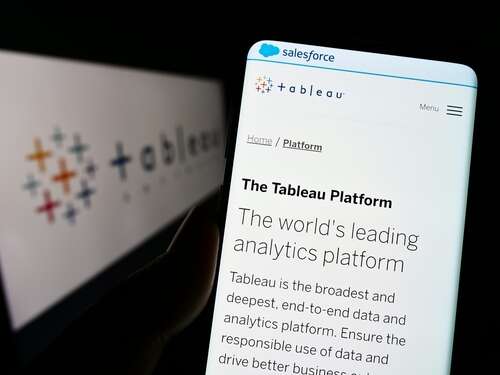
The Covid-19 pandemic was undoubtedly good to Salesforce. As businesses around the world were forced to move their operations online at unprecedented speed in 2020, demand for its cloud-based customer relationship management (CRM) tools rocketed, and revenues soared accordingly.

Fast forward three years and things aren’t looking quite so rosy. “Customers are taking a more measured approached to purchasing decisions,” lamented Salesforce founder and CEO Marc Benioff as he announced plans to lay off 7,000 staff at the start of January in the face of the economic headwinds that have buffeted the tech industry. “As our revenue accelerated through the pandemic, we hired too many people,” he said.
As Salesforce’s income shrinks, Benioff is also facing pressure from shareholders eager for a return on their investment. His strategy for the business has prioritised growth over dividends, with more than $50bn invested in the acquisitions of companies including enterprise messaging platform Slack and business intelligence software developer Tableau. The latter is set to bear the brunt of the upcoming Salesforce job cuts, with Bloomberg reporting earlier this month that many of Tableau’s senior staff have already followed CEO Mark Nelson out of the door.
Faced with a leadership vacuum, and a highly competitive marketplace, Tableau, the long-time market leader in BI software, is staring at an uncertain future. Greater integration with Salesforce seems inevitable, but could come at the cost of its status as a standalone product.
Salesforce and Tableau: a mutually beneficial partnership
Tableau was founded in 2003 and provides data visualisation tools which help organisations understand and analyse their business data. Customers include the NHS, for which the company provided data dashboards during the pandemic, as well as business big names such as Verizon, ABB and SwissRe.
The company was acquired by Salesforce in 2019 for $15.7bn. “Tableau is an extraordinary company, with an amazing product and team and an incredibly passionate community,” Benioff said at the time. “Together we can transform the way people understand not only their customers, but their whole world – delivering powerful AI-driven insights across all types of data and use cases for people of every skill level.”
It’s hard to judge how successful the deal has been in financial terms for Salesforce, as the company does not break out individual revenue for Tableau in its financial reports. Its 2022 full-year results show that its revenue from its data division, which includes Tableau and its other analytics functions as well as its integration products, was $3.7bn, up from $2.9bn the year before. Tableau’s last reported revenue as an independent business was $1.2bn, in 2018.
But joining forces was a sensible move at the time, says Rena Bhattacharyya, service director of enterprise technology and services at GlobalData. “It was a good acquisition for both parties,” she says. “For Tableau, it brought it the potential to have access to an enormous user base. So many organisations use Salesforce internally, and the opportunity to try and push them the additional solutions that Tableau brings to the table was a good one – and provided an opportunity for Tableau and a way for it to differentiate itself from its competitors.”
For Salesforce, Bhattacharyya says the purchase gave it “the analytics capabilities that it really needed to offer its clients to get to the next level”. She adds: “I think it was a good deal and nothing that has happened recently changes that.”
Tableau vs Power BI
In the business intelligence market, Tableau faces fierce competition from Microsoft’s Power BI suite of tools. Data collected by enterprise IT buying platform TrustRadius in 2021 showed that MSFT’s product had a 36% market share, compared to Tableau’s 20%.
The power and reach of the Microsoft ecosystem is likely to draw more businesses away from Tableau to Power BI according to product designer Robert Janezic, a long-time Tableau enthusiast and founder of Tableau UI Kit prototyping tool.
In a viral Twitter thread, Janezic wrote: "In the coming three-five years I believe Tableau will lose more and more market share to Power BI (...) The Microsoft business ecosystem is nearly unstoppable. Think about the foundational apps companies use. Word, Powerpoint, Excel, Outlook. Office 365 is an all-in-one bundle. Remember, it's not just the tool that's important. It's the ecosystem."
Is Tableau dead? 💀
— Robert Janezic (@RobertJanezic) January 9, 2023
I've been thinking about the future of the tool a lot lately, and here's my thoughts 🧵
Bhattacharyya says Tableau has "a solid solution to offer" in comparison to Power BI, but adds: "Companies such as Microsoft do have an advantage in that they offer an end-to-end analytics lifecycle. They cover a broad spectrum that starts with data collection and data management and they have a very solid footing there. This enables them to provide a cohesive user experience and that's a definite advantage.
"It's an area where [Tableau and Salesforce] needs to build up its story a bit - I think that's a challenge for them."
What is the future of Tableau?
Writing the next chapter of that story will have to be done with a significantly reduced workforce following the layoffs. Salesforce has grown across all divisions at a rapid pace in the last decade, regularly adding more than 20% to its headcount. In 2022, figures show its team swelled by 29.9%.
Who will steer this considerably smaller ship remains unclear, with CEO Mark Nelson having left the company in December. Nelson had been at the helm of Tableau for two years following the departure of Adam Selipsky, who led the company through the Salesforce acquisition but was subsequently poached by Amazon to lead its public cloud division, AWS.
Nelson's departure came during a turbulent period in the Salesforce boardroom, which also saw co-CEO Bret Taylor step down, and the co-founder and chief executive of Slack, Stewart Butterfield, leave the company. Butterfield was immediately replaced by Lidiane Jones, Salesforce's erstwhile executive VP and GM for digital experiences clouds, but the other two positions remain vacant.
It was reported at the time that Nelson may not be directly replaced, with his responsibilities shared between other senior leaders. Tech Monitor has approached the company for comment on whether a new CEO is likely to be appointed, but the continuing absence of a figurehead for the business lends credence to suggestions that Salesforce increasingly sees Tableau as a data visualisation function of its platform rather than a brand in its own right. Tech Monitor understands that tensions often run high within the companies about whether products are branded Salesforce or Tableau.
Benioff hailed the closer relationship between the two businesses at the company's Dreamforce conference last year, giving a demonstration of how much easier it was becoming to use Tableau to analyse data in Salesforce's CRM. Bhattacharyya argues this will be useful for clients. "I expect there is more integration to come and I think that will be to the benefit of Salesforce and Tableau users," she says. "The two products have been developing independently and have come across as separate organisations. They have been working together - it's not like that hasn't been happening at all - but I think greater integration is the way to realise the full benefits of their software to customers."
But Janezic believes the Salesforce-ification of Tableau has already come at the cost of the very same "passionate community" of users Benioff was courting in 2019. "The user community have been at odds with the direction of things for some time," Janezic wrote on Twitter, saying that users have voiced "displeasure with new features that are mostly focused around integrations, instead of quality of life improvements that have been sitting on the ideas page for a decade."
Janezic said: "These feature decisions haven't really made people switch completely. But it has made users question their future with the tool and has increased the likelihood they look into a different tool - or, take that job with a different company that uses a different tool. It's a slow burn."






